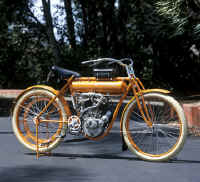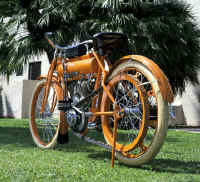|


Considering
the social advances and opportunities of the times, the years between
1910 and 1920 are often referred to as the Golden Decade of American
Motorcycling. While
America was beginning the second decade of the 20th
century, The Mechanical Age continued to bear fruit and many products
were developed that aided the citizen, enhanced his life, and boosted
his production.
Simultaneously with the release of his innovative Model T,
Henry Ford would raise the wage of the daily worker in America to an
unheard of sum of five dollars per day.
The nation was riding a wave of rich industrial development
that was enhanced by rapid technical innovation.
The fledgling motorcycle industry was no different.
Small American motorcycle manufacturers like Standard
Reading, Pope, Cyclone, Henderson, Thor, and a myriad of others---as
well as “The Big 3” of Indian, Excelsior, and
Harley-Davidson---were producing motorcycles into the domestic market,
often while pursuing wildly divergent development technologies.
Spurred on by an American belief in ingenuity and driven by
the burgeoning transportation needs of a restless country, new
builders were emerging, all ready to try their hand at their own brand
of engineering and design.
Joseph I. Merkel was such a
man.
Originally centered in Milwaukee, Merkel built a few
single-cylinder, belt-drive machines utilizing ingenuity of his
own…his machines featured integral exhaust systems that used frame
tubes as silencers, an easier-to-use incorporation of throttle opening
and spark advance, and an innovative oil system.
The Merkel company soon merged
with a small manufacturing firm in Pottstown, Pennsylvania where the
machines continued to incorporate other ingenious designs---most of
which were quickly adapted by the larger manufacturers.
These included a sprung swing-arm and a telescoping front fork
that are clear predecessors of modern frame design.
Soon, Merkel was offered another merger and he joined a
bicycle-manufacturing firm in Middletown, Ohio where manufacturing
began in earnest with the introduction of the first big bore V-Twin,
which used a 61 cubic inch motor.
He now called his machines “Flying Merkels.”
Merkel insisted on superior build-quality and he personally
scrutinized the building of most Flying Merkel models.
His big-bore Merkels were successfully raced by the great
Maldwyn Jones, among others, and they would garner racing tributes
well into the mid-decade both on dirt tracks and “on the boards.”
The 1911 sales-brochure for Flying Merkel advertises that a
“Flying Merkel achieved a distance of one measured mile in 41.4
seconds.” That’s a
tick under 87mph and pretty darn quick for 1911.
Some innovations proved to be “spot on” while others perhaps fell
a bit wide of the mark. Soon,
sales competition would prove the Merkels to be too expensive to
produce and with gathering war clouds looming over Europe, the larger
displacement machines would begin to be phased out circa 1914.
Sadly, Merkel production would cease soon after.
But the legacy and vision of
Joseph Merkel would live on.
Mike Madigan is a collector/restorer with a serious passion
for older bikes. He owns
many belt-drive era machines and acquired this 61 inch 1912 Flying
Merkel V-S under rather remarkable conditions.
It seems the bike was purchased
new in San Diego in 1912 and saw relatively few miles before the
original owner secreted it behind a false wall in his home prior to
leaving for war-torn Europe during WWI.
He never returned to reclaim his machine and it sat undisturbed
and unremembered for nearly sixty years until it was discovered during
demolition of the old house in Carlsbad, California for freeway
expansion in 1970.
The next man who acquired the machine started its
restoration but lost interest for various reasons and allowed the bike
to languish. That owner
eventually read an article about the Madigan collection and offered
the machine to Mike.
According to Mike, the machine
was in very good shape when originally rediscovered although its
subsequent storage proved less than ideal.
The seat, the drive belt, and the original paint had been
allowed to suffer while the disassembled machine was stored outside.
Sad stuff, this, after the bike had survived 60-odd years of
nearly archival preservation.
Madigan
had a new saddle made from the original Merkel shop-pattern, new tires
were installed, and also a new V-belt was constructed.
The late Cliff “Slippery” Hills, of whom Mike speaks most
fondly, restored the motor. “Cliff
was the kind of guy who could hold an old carburetor like one of these
in his hands and make it work again,” says Madigan with a smile.
Mark Jahn, noted Indian restorer, handled all the cosmetics
and the machine was restored in its correct 1912 livery complete with
flashy orange paint and delicate black pin-striping. The repop Coker
28X2.5/2 tires are correct in their natural rubber color.
The entire machine is quite narrow with the motor measuring
less than six inches wide at the crankcases.
The widest part of the machine, disregarding the pull-back
handlebars, is the seat. The “inlet over exhaust”--or IOE
configuration--uses atmospheric intake valves while the exhaust valves
are pushrod operated. A
Bosch magneto mounted on the crankcase front handles the electrics. The Eclipse mechanical clutch is operated by a gated-lever
mounted on the left side of the machine and has nearly a dozen detents
between full-engagement and full-release.
The Flying Merkel owed much of
its popular success (and its high price) to its high-tech motor.
The big V-twin used ball-bearings on connecting-rod big-ends
and on main bearings, rather than the bronze bushes that were common
on most machines of the era. Flying Merkels also offered a primitive
but automatic variable-supply lubrication system that was controlled
by the throttle position. This
nearly eliminated the need for a rider to periodically pump a
“total-loss” system although provisions for an occasional
“assist” were provided for use during spirited engine speeds or a
heavy climb.
The operation of machines from this era requires a
different set of rules. The
drill is as follows: set
the bike on its rear-wheel stand and fill the crankcase with the
required amount of oil using the provided glass syringe.
Retard the ignition and engage the clutch.
Set the throttle and choke/prime the carburetor.
Raise both exhaust valves with the bar end de-compressor latch. Pedal until the motor chuffs into life, then drop the exhaust
valve latch allowing full compression.
Throw out the clutch to release the rear wheel and belt. Adjust
the ignition advance and throttle position as needed while the motor
warms. Adjust the
automatic oiler for appropriate setting and check for the correct
exhaust color denoting proper oiling.
Clip up the rear stand. Mount
the machine and begin to pedal away while feeding in some clutch. The
clutch detents allow the clutch friction to be modulated while both
hands are busy adjusting the left grip for magneto advance and the
right grip for throttle position. Continue to adjust throttle and timing while gradually
clicking the clutch through the detents until full lock-up is
achieved.
Knowledgeable collectors say these machines could run at
60mph at full-chat. Slow
speed running is a bit more problematic and requires attention to both
carefully retarded timing and appropriate use of the valve-lifter. A careful eye on the exhaust color and a well-schooled ear is
necessary to provide adequate power and a smooth-running, no-knock
engine.
The geometry of the cradle
frame shows the bicycle heritage of the Merkel line, as do the pedals,
handlebars, and the coaster-style rear brake.
The front down-tube on the frame employs a gooseneck bend to
incorporate the slim crankcase. The
elegant forward sweep of the front fork assembly plus the low slung
fuel/oil tank make the bike appear fast even while sitting still.
As a design form, the Merkel is as pretty as any machine of any
era.
To have owned and ridden this
bright orange motorcycle in 1912 would have been a treat that we can
only imagine. The Coolest
Kid in Town? I think so.
©Joe Michaud 2001
|

